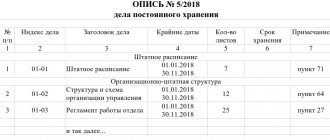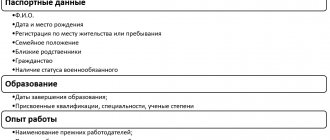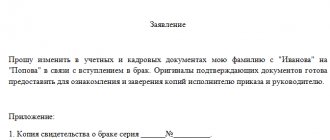Who are the personal files for?
Personal files are maintained: – for managers and specialists; – scientific workers; – civil servants; – other employees in cases determined by the legislation of the Republic of Belarus. Other employees include, in particular, persons obligated to reimburse expenses spent by the state on the maintenance of children who are on state support. Personal files for obligated persons (regardless of their position or profession) are formalized by the labor, employment and social protection authorities (part two of clause 5 of the Regulations).
Deadlines for filing a personal file
As a rule, a personal file is opened for an employee for the first time after he has signed an order for his employment and has become familiar with this order.
The personal file is maintained, supplemented with documentation, and updated throughout the entire time the employee works for this employer. Unlike personal affairs in the public service, it is not customary for private entrepreneurs to disclose personal affairs when changing jobs. The relevance of a personal file lasts until it is transferred to the archive due to the dismissal of an employee.
What documents are included in a personal file?
An employee’s personal file is formed after concluding an employment agreement (contract) and issuing an order (order, decision, resolution) on hiring (appointment to a position). When creating a personal file, documents are included in it in the following sequence: – internal inventory of personal file documents; – addition to the personal personnel record sheet; – personal personnel record sheet; – autobiography; – copies of documents on education, advanced training, retraining; - application for a job; – a copy (extract) of the order (instruction, decision, resolution) on employment (appointment to a position) (clause 6 of the Instructions for maintaining personal affairs). When forming personal files of certain categories of employees, they additionally include the following documents: – income statement (for persons authorized to perform government functions, and persons equivalent to them, as well as other employees in cases provided for by law); – obligation to comply with the restrictions provided for by anti-corruption legislation; – contract (for civil servants); – reference lens; – questionnaire; – a copy (extract) of the minutes of the meeting of the academic council (for researchers and teachers of higher educational institutions who have passed the competitive selection to fill vacant positions); – a copy (extract) of the minutes of the general meeting of the labor collective (for managers elected to office by the labor collective); – a copy (extract) of the founders’ decision on appointment to the position of head of the organization; – agreement on financial liability (for financially responsible persons); – referral to work (by the employment service for young specialists after graduating from state educational institutions, referral by reservation for conscripts discharged from the Armed Forces of the Republic of Belarus, etc.). In the process of maintaining a personal file, it includes documents characterizing the business, socio-political, scientific and personal qualities of the employee: – characteristics and certification sheets; – lists of scientific works and inventions; – employee applications for transfer, dismissal, other documents that served as the basis for the transfer, dismissal of the employee; – copies (extracts) of orders (instructions, decisions, resolutions) on transfer, dismissal, award, change of name, assignment of classes, qualification categories, ranks, titles, etc.; – other documents provided for by the legislation of the Republic of Belarus. By decision of the personnel service (HR specialist), employment agreements (contracts) with employees are included in personal files. Documents are included in the generated personal file in chronological order.
For a sample of the internal inventory of personal file documents, see the “Useful Documentation” section on p.
24 magazines.
Is it necessary to keep personal files?
Most entrepreneurs consider personal files an essential component of personnel documentation. However, the law states that this is only true for civil servants.
Personal files for government employees
Information about state and municipal employees must be systematized in the prescribed form (Decree of the President of the Russian Federation of May 30, 2005 No. 609). The personnel files of such employees are intended to reflect their entire track record so that it can be clearly seen how exactly their personal data has changed.
If an employee moves from one structure to another, his personal file must follow.
At a new place of work, it will be easier to form an impression of a new person, as well as obtain additional information about sources of income, connections, professional network, as well as other information that facilitates control.
Federal Law No. 79-FZ “On the State Civil Service of the Russian Federation” dated July 27, 2004, in Part 3 of Article 42, reveals the procedure for all actions with the personal files of this category of employees.
How to draw up an act of acceptance and transfer of the personal file of a municipal employee ?
Personal affairs of entrepreneurs
Neither the Labor Code nor other regulations of the Russian Federation contain a mandatory requirement to maintain personnel documentation exclusively through personal files created for each employee. Therefore, such registration of personnel data is not at all mandatory or even recommended.
IMPORTANT! The laws of the Russian Federation do not prohibit legal entities or individual entrepreneurs from maintaining personal affairs for their employees.
If the management of an organization or individual entrepreneur has decided to make it mandatory to fill out personal files, this must be enshrined in the accounting policy by prescribing the procedure in internal regulations. As a rule, it is the case that they use the regulations developed for civil servants.
Advantages of the personal affairs system for an entrepreneur
Despite the fact that no requirements define or limit the composition of a personal file and the procedure for maintaining it, the practice of this branch of office work shows the undoubted convenience for the manager of this form of storing personal information. It is for this reason that the ubiquity of personal files in the personnel service has formed the myth of their obligatory nature.
The positive effect of introducing personal personnel records is obvious:
- timely recording of all employee documentation;
- tracking career dynamics;
- recording data on possible benefits;
- assessment of prospects for professional growth;
- safety and orderliness of personal documentation;
- prompt access to the entire range of personnel information.
How to fill out a personnel registration form?
For an example of completing an addition to a personal personnel record sheet, see the “Useful Documentation” section on p. 24 magazines.
The personal personnel record sheet is drawn up in the prescribed form, which is attached to the Instructions for maintaining personal files. The personal personnel record sheet is filled out by the applicant with his own hand in one copy without erasures or corrections on the basis of a passport, military ID, work record book, education documents and other personal documents. The completeness and correctness of filling out the personal sheet are checked by a personnel service employee (HR specialist), who checks the correspondence of the entries made in the personal sheet with the entries in the documents. When filling out a personal personnel record sheet, the following requirements are met: – all questions on the personal personnel record sheet must be given comprehensive answers, which should not be monosyllabic “yes”, “no”; – crossing out columns is not allowed; in case of a negative answer, the following is indicated: “I don’t have”, “did not participate”, etc.; – surname, name, patronymic are written entirely in the nominative case. For example, Sidorsky Oleg Nikolaevich; – in the “Date of Birth” column, the date, month and year of birth are indicated in Arabic numerals. For example, 08/15/1962; – place of birth is indicated in accordance with the administrative-territorial division at the time of birth. For example, BSSR, village. Lenki, Slutsk district, Minsk region; – in the “Citizenship” column the name of the country is indicated (Republic of Belarus, Russian Federation, etc.); – in the column “Education” the following is indicated: “general secondary”, “vocational-technical”, “special secondary”, “higher”; – if the educational institution is not graduated, indicate how many courses you completed or which course you left; for those who graduated from junior high school, indicate how many classes you completed;
– the names of higher and secondary specialized institutions are written in full;
– in the column “What works and inventions do you have”, published scientific works are listed with an indication of the output data, patented inventions, or the entry is made: “The list of scientific works (inventions) is attached”; – in the column “Work performed since the beginning of work” previous work activity is reflected, as well as breaks related to study, illness, etc. If an employee in the same organization held different positions at different periods of time, then it is indicated from when and for what time he worked in each position; – in the column “Marital status” the data at the time of filling out the personal form is indicated: “single (not married)”, “married (married)”, “divorced (divorced)”, “widower (widow)”, then all family members are listed indicating the degree of relationship (last name, first name, patronymic and year of birth of each family member are recorded). For example: married: wife – Elena Konstantinovna Trofimova, born in 1964, son – Kirill Olegovich Sidorsky, born in 1988, daughter – Anastasia Olegovna Sidorskaya, born in 1992, mother – Nina Pavlovna Gurevich, born in 1937 .;
For a sample of filling out a personnel records sheet, see the “Useful Documentation” section on p. 25 magazines.
– in the column “Place of residence” the registration address, actual residential address and telephone number are indicated. A photograph of the person being hired is pasted onto the personal personnel record sheet. The personal personnel record sheet is signed by the compiler indicating the date of completion. Changes and additions to the personal personnel record sheet after it is filled out are not made. All changes in information that occurred with the employee while working in the organization (change of last name, obtaining a higher level of education, etc.) are reflected in the addition to the personal personnel record sheet.
How much to store and where
In the HR department, employee files are kept throughout the entire period of their work in the organization. For these purposes, a special place is equipped to prevent access to them by third parties, as well as the possibility of their theft or loss. Typically these are locked safes or metal cabinets or rooms.
When an employee resigns, the personal file is closed. The case is closed - this means that it is completely processed and completed. In this case, first, an internal inventory is filed with a final record of the number of sheets and documents in it, and at the end - a certification sheet. The title page indicates the date of closure of the case (date of dismissal) and the period of its storage, which begins to be calculated from January 1 of the year following the year of closure.
The personal files of those dismissed are kept in the organization for three years, then are handed over to the archives. If the file was created after 2003, then its storage period is 50 years, if earlier - then 75 years (Article 22.1 of the Federal Law of October 22, 2004 No. 125). If your personal file contains documents with different maximum storage periods, then the entire file is stored according to the older period.
How is an autobiography written?
An autobiography is a document containing a brief summary of the main stages of the life and work of its author in chronological order. It is compiled by the employee independently in any form on a sheet of A4 paper. The autobiography reflects the following information: – last name, first name, patronymic; - Date and place of birth; – education received (where, when and in what educational institutions did you study); – work activity; - profession; – social work, participation in elected bodies; – attitude towards military service and military rank; – availability of government and other awards and incentives; – information about marital status, relatives living together (father, mother, children). The autobiography is signed by the compiler indicating the date.
Sample of filling out an autobiography
Autobiography
I, Shcheglova (Fedortsova) Irina Petrovna, was born on September 12, 1984 in the city of Minsk. From 1991 to 2001 studied at secondary school No. 45 in Minsk. She graduated from school with a gold medal. From 2001 to 2006 Studied at the Belarusian State Economic University at the Faculty of Law. Qualified as a lawyer. She began her career in 2006 at Tracky LLC as a legal consultant. In 2010, she was transferred to the position of leading legal adviser. Resigned from Tracks LLC on May 4, 2014. From 2014 to 2015 worked as a leading legal consultant at GruppaM LLC. I did not take part in elected legislative and representative bodies. I'm not a member of a trade union. Not liable for military service. Family status: Married. Husband - Shcheglov Ilya Vladimirovich, born in 1980, works as an engineer at Advance LLC. Daughter – Shcheglova Sofia Ilyinichna, born in 2007, studies at gymnasium No. 2 in Minsk. Father - Fedortsov Petr Olegovich, born in 1950, retired. Mother – Fedortsova Olga Andreevna, born in 1951, pensioner. Together with my husband and daughter I live at the address: Minsk, st. Lidskaya, 25-12. Phone: +375 17 236 45 16.
Shcheglova 10.29.2015
Storage
The personal file is kept by the responsible employee who forms and supplements it. As a rule, this is done by the personnel officer.
If the management of a personal file is regulated by local documents, then it would be useful to indicate in them a list of officials who may have access to personal identification documents. Because due to the confidentiality of the documents contained in it, there cannot be free access to the personal file.
That is why they should be stored either in a safe or in another inaccessible place.
Video - employee personal card T-2 - cardboard or paper:
What educational documents are filed in a personal file?
Education document – a state-issued document confirming that the student has mastered the content of the relevant educational program, incl. with the assignment of qualifications (clause 1 of article 98 of the Education Code). In paragraph 2 of Art. 98 of the Education Code provides a list of education documents: – certificate of general basic education (certificate of general basic education with honors); – certificate of general secondary education (certificate of general secondary education of a special type with a gold (silver) medal awarded); – Diploma of vocational education (diploma of vocational education with honors); – diploma of secondary specialized education (diploma of secondary specialized education with honors);
– diploma of higher education (diploma of higher education with honors, including a gold medal);
- master's degree; – research diploma; – diploma of retraining at the higher education level; – diploma of retraining at the level of secondary specialized education; – certificate of advanced training. Copies of documents on education, advanced training and retraining (certificate, diploma, certificate, etc.) included in a personal file must be certified in the prescribed manner (clause 15 of the Instructions for maintaining personal files). A copy of the document must reproduce all the details of this document, incl. form details. To give a copy of a document legal force, it must be certified (witnessed) by an authorized official of the organization (clause 64 of the Instructions for Office Management). A note on certification of the copy is drawn up below the “Signature” detail and includes the word “True”, the name of the position of the person who certified the copy, his handwritten signature, the transcript of the signature and the date of certification.
For example: True Leading HR specialist Signature 10/29/2015 A.P. Zvezdochkina
Features of creating a personal file
Correct registration of personal files greatly facilitates the work with personnel documentation. Practice has developed a number of recommendations regarding the effective formation of personal files:
- Documents are collected under one cover, most often a folder, less often just a file or binder. They must be separate for each employee.
- It is not advisable to form cases thicker than 4 cm.
- Documents for permanent storage should not be mixed with temporary documents.
- The personal file may contain both original documents and their certified copies.
- It is preferable to replace important documents of permanent storage for personal files with copies.
- It is not customary to store several copies of the same document within one personal file.
- If the document contains attachments, they must be stored along with the relevant papers.
- Documents in the file should be arranged chronologically, that is, as they arise.
REMEMBER! The archives accept personal files for storage only in cardboard folders. Binders and files are not acceptable for this purpose and may only be for internal use.
Common personal file mistakes
Error 1. You can store copies of any documents in an employee’s personal file.
How right. Not all documents can be stored in the employee’s personal file. You cannot store documents that are not related to the performance of official duties in your personal file. Documents that are safe to keep in your personal file are:
- employment contract;
- orders;
- questionnaires;
- work book;
- other documents permitted by law (see table at the beginning of the article)
It is not safe to keep copies of the following documents in your personal file:
- TIN;
- SNILS;
- passports;
- military ID;
- marriage certificates;
- birth certificates of children, etc.
Moreover, you can request such documents when registering an employee, but you cannot store them. Roskomnadzor insists on this. This position is also shared by judges, this is particularly stated in the Resolution of the Kirov Judicial District of the city of Astrakhan in case No. 5-244/2012 dated 05.24.12 and in the Resolution of the Arbitration Court of the North Caucasus District in case No. A53-13327/2013 dated 21.04 .14.
For violation of these rules, an administrative fine is provided, which can reach up to 50,000 rubles. This is stated in Part 1 of Article 13.11 of the Administrative Code. An organization or individual entrepreneur with employees may be given a warning, but if they do not respond and correct the situation, they may face the following fines.
| Who will be subject to an administrative fine? | Amount of fine, in rubles |
| For an individual | 1 000 – 3 000 |
| For an official | 5 000 – 10 000 |
| For a legal entity | 30 000 – 50 000 |
Logbook: how to keep it
It is necessary to take into account personal files opened for employees. Its standard form has not been approved, which means you can take a sample from the Internet or purchase it in a store. The content of each column can be changed depending on the organization.
The log contains: case numbers, their start date, surname and initials of employees and other information. When a personal file is closed, a note is made in the journal: they put a date and enter the reason why the case was closed.
Additional information is usually entered in the “Other” or “Notes” column.
How to deal with the affairs of dismissed employees
When a person quits, his file is closed, removed from the file and filed. In this case, a certification sheet must be drawn up. It includes data on how many sheets are stitched and numbered. This sheet also indicates whether there are damaged documents in the case, or whether new ones have been attached.
The certification sheet is pasted onto the cover of the case from the inside. The HR employee puts his signature on this sheet.
An employee’s personal file is kept in the archive for 75 years; for managers, this period is usually longer. But at the same time, if on the last working day an employee asks for copies of the necessary documents, this can be done; in this case, the file will not have to be stored, and the archive will be unloaded.
Order of business
This process includes:
- Making entries in the relevant sections;
- The procedure for removing documentation that has become irrelevant or is no longer needed;
- Checking personal files for the safety of documentation;
- Storing documentation as part of a personal file.
If an employee's personal information changes, they usually report this to the HR department. It is better, of course, to do this in writing. After the HR department employee makes the appropriate entry into the file, the original document is returned to the employee. If necessary, you need to make a copy of the document and attach it to the file.
All entries are made only based on original documentation or copies certified by a notary. Entries are made by hand in black, blue or purple ink, carefully, avoiding blots and corrections. If necessary, the records are certified using the organization’s seal and the signature of the HR department employee.
It is not recommended to use gel pens for writing, as this type of ink is subject to rapid fading.
All sheets that are filed in the file are numbered. And the numbering is reflected in the internal inventory. Such an inventory is compiled to take into account documents that have been stored for more than 10 years.
If the case is being prepared for submission to the archive, all sheets of the internal inventory are also numbered, only separately from the sheets of the case.
Sample title page design
GOST 17914-72 dated July 17, 1972 regulates the rules for registering personal files, they are as follows:
- At the top of the title page there may be information that is allowed to be filled out only by the municipal or state archive, these are codes, dates of submission of documents to the archive, and more.
- In the center of the title page, slightly indented from the top, you must indicate the name of the organization. As a rule, the abbreviated name of the company is written in this place.
- Below the name of the company, the department in which the new employee works is indicated.
- Then the case number is indicated, which is taken in brackets. It must be preceded by an index, also in parentheses.
- Then the title of the personal file is written. The last name, first name, and patronymic of the employee are used as the heading.
- The lower right corner of the title page is intended for information such as the date of hiring the employee, the day of dismissal, the storage period of documentation, the date of filing in the archive, and more.








